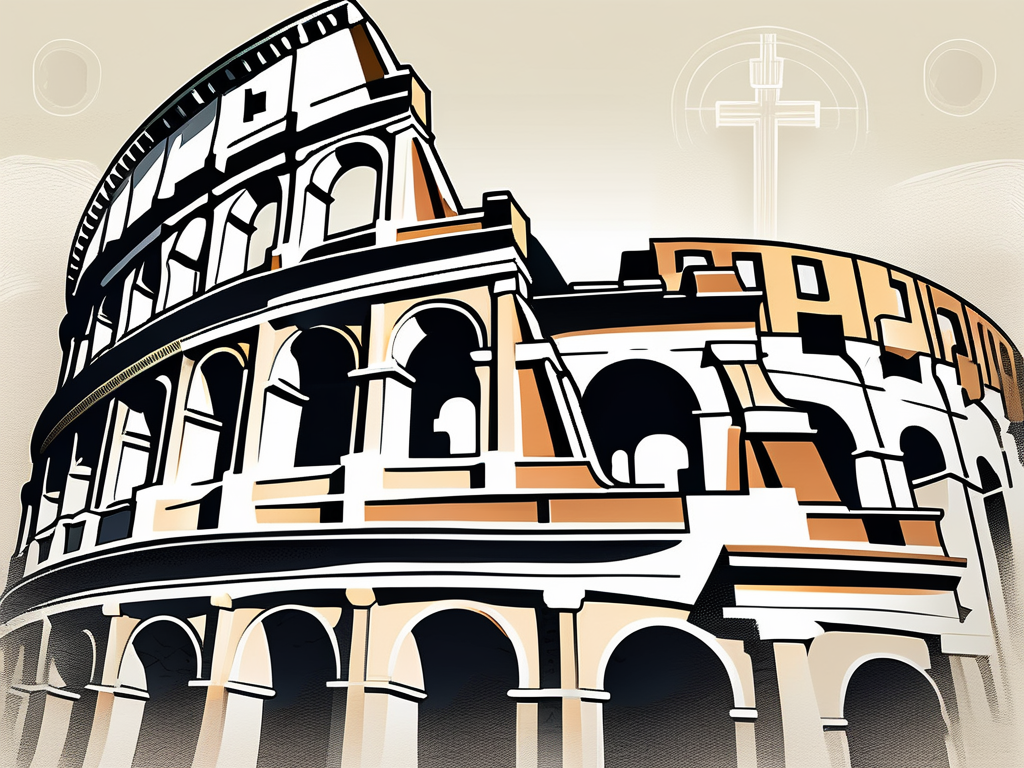The story of Jesus Christ is one of the most profound narratives of faith that has ever been told. It is a story that has captivated the hearts and minds of millions of people throughout history. To truly understand the significance of Jesus Christ’s life, it is important to delve into the historical context in which he lived.
Understanding the Historical Context of Jesus Christ’s Life
The time in which Jesus Christ lived was a pivotal period in history. The Roman Empire held sway over a vast expanse of territory, including the region of Judea, where Jesus was born and raised. This was a time of great political and social upheaval, as the empire sought to impose its authority on the Jewish society.
Judea, at the time, was a land of contrasts. On one hand, it was a deeply religious and traditional society, with a strong sense of Jewish identity and a rich history of prophets and kings. On the other hand, it was under the oppressive rule of the Roman Empire, which sought to assimilate and control the Jewish people.
The Roman Empire had a significant impact on Jewish society during this time. Jews were subjected to Roman laws and taxes, and tensions between the Jewish people and their Roman rulers were high. The Romans, in an effort to maintain control, appointed local leaders to govern Judea, often causing further division and resentment among the Jewish population.
The Roman Empire and Jewish Society
Under Roman rule, the Jewish people faced numerous challenges to their religious practices and beliefs. The Romans built temples and shrines dedicated to their own gods, which were seen as a direct affront to the Jewish faith. Additionally, the Romans imposed heavy taxes on the Jewish population, causing economic hardship and further straining relations between the two groups.
Despite these challenges, the Jewish people remained steadfast in their faith and continued to worship in their synagogues and observe their religious rituals. The teachings of the prophets, such as Isaiah and Jeremiah, provided hope and guidance during these tumultuous times.
The Birth of Jesus: Prophecies and Miracles
The birth of Jesus Christ is shrouded in prophecy and miracles. According to the Bible, Jesus was born in Bethlehem, the city of David, fulfilling ancient prophecies. His birth was heralded by a star, guiding wise men from the East to worship him. It was in this humble setting that the story of Jesus Christ began to unfold.
The birth of Jesus was not only significant for the Jewish people but also for the entire world. It marked the beginning of a new era, a time of hope and redemption. The miracles surrounding Jesus’ birth, such as the visitation of angels and the appearance of the star, served as a testament to his divine nature and purpose.
As Jesus grew older, he became known for his wisdom and teachings. He challenged the religious authorities of his time and preached a message of love, forgiveness, and salvation. His words resonated with the common people, who were weary of the oppressive Roman rule and longed for a better future.
Throughout his ministry, Jesus performed numerous miracles, healing the sick, raising the dead, and demonstrating his power over nature. These miracles not only served as evidence of his divine authority but also brought hope and comfort to those who witnessed them.
In conclusion, the historical context of Jesus Christ’s life was one of political and social turmoil, as the Roman Empire exerted its control over the Jewish society. However, amidst this challenging backdrop, Jesus’ birth and ministry brought a message of hope and redemption, offering solace to a people longing for deliverance.
The Teachings and Parables of Jesus
Central to the story of Jesus Christ are his teachings and parables. Jesus was a master storyteller, using relatable parables to convey deep spiritual truths. His teachings challenged conventional wisdom and urged his followers to embrace a life of compassion, forgiveness, and humility.
Jesus’ teachings were not just mere words, but transformative messages that continue to resonate with people today. His words were filled with wisdom and love, inviting his listeners to see the world through a different lens. He taught his followers to love unconditionally, to show kindness to strangers, and to forgive those who have wronged them.
The Sermon on the Mount
One of the most well-known teachings of Jesus is the Sermon on the Mount. In this sermon, Jesus outlined the core principles of his message, including the Beatitudes, which showcased the values of the Kingdom of God. He taught his followers to love their enemies, pray for those who persecute them, and seek first the Kingdom of God and his righteousness.
The Sermon on the Mount was a radical departure from the prevailing religious teachings of the time. Jesus challenged the religious leaders and emphasized the importance of inner transformation rather than mere outward observance of religious rituals. He called his followers to be salt and light in the world, to be agents of change and love in a broken and hurting world.
Parables and Their Interpretations
Throughout his ministry, Jesus used parables to illustrate powerful lessons about God’s kingdom and human nature. From the parable of the Good Samaritan to the Prodigal Son, each story carried a deeper meaning and challenged his listeners to examine their hearts and actions.
The parables of Jesus were not just entertaining stories, but profound metaphors that revealed the nature of God and the human condition. They invited his listeners to reflect on their own lives and consider the implications of their choices. The parable of the Good Samaritan, for example, taught the importance of showing compassion to all people, regardless of their social status or background.
Jesus’ parables were often open-ended, leaving room for interpretation and personal reflection. They were meant to provoke thought and encourage his followers to live out the values of the Kingdom of God. Each parable was a window into the heart of God, revealing his love, mercy, and desire for reconciliation.
As we study the teachings and parables of Jesus, we are reminded of the profound impact he had on the world. His words continue to inspire and challenge us to live lives of love, compassion, and humility. May we strive to embody his teachings and share his message of hope and redemption with others.
The Miracles Attributed to Jesus Christ
One of the remarkable aspects of Jesus Christ’s life is the multitude of miracles he performed. These miracles served as signs of his divine authority and power, reinforcing his message and showing compassion for those in need.
Let us delve deeper into the miracles attributed to Jesus Christ and explore the profound impact they had on the lives of those who witnessed them.
Healing the Sick and Raising the Dead
Jesus demonstrated boundless compassion and healing to those who were sick and suffering. His touch brought forth miraculous cures, restoring health and vitality to those who had lost all hope. The blind were able to see, the deaf could hear, and the lame were able to walk again. These incredible acts of healing not only provided physical relief but also symbolized the hope of eternal life that Jesus offered to all.
One of the most awe-inspiring miracles performed by Jesus was raising the dead. In a display of divine power, he called Lazarus, who had been dead for four days, back to life. This astonishing event left those who witnessed it in awe, as they witnessed death being conquered by the very source of life itself.
Nature Miracles: Walking on Water and Feeding the Multitudes
In addition to healing the sick, Jesus performed breathtaking miracles in nature that left his disciples and followers astounded. One such miracle was when he walked on water, defying the laws of physics and showcasing his complete mastery over the elements. As the stormy sea raged around him, Jesus calmly walked upon the turbulent waters, demonstrating his divine authority over nature itself.
Another remarkable nature miracle performed by Jesus was the feeding of the multitudes. With just a few loaves of bread and a handful of fish, he miraculously multiplied the food to feed thousands of hungry people. This act of abundance not only satisfied their physical hunger but also symbolized Jesus’ ability to provide for all our needs, both material and spiritual.
It is important to note that these miracles were not mere displays of power, but rather acts of love and compassion. Jesus performed these miracles out of a deep desire to alleviate suffering, restore hope, and reveal his true identity as the Son of God.
As we reflect on the miracles attributed to Jesus Christ, we are reminded of his unwavering love for humanity and his ability to transform lives. These miracles continue to inspire and provide solace to those who seek comfort and reassurance in their faith.
The Crucifixion and Resurrection
The culmination of Jesus Christ’s earthly journey was his crucifixion and resurrection. These events are central to the Christian faith, representing the ultimate sacrifice and triumph over death.
The Last Supper and Betrayal
Prior to his crucifixion, Jesus shared a final meal with his disciples, known as the Last Supper. During this time, he predicted his betrayal by one of his closest followers, Judas Iscariot. This betrayal set in motion the events that would lead to Jesus’ crucifixion.
As they gathered around the table, Jesus took a loaf of bread and broke it, symbolizing his body that would soon be broken on the cross. He then passed around a cup of wine, representing his blood that would be shed for the forgiveness of sins. The disciples, unaware of the impending tragedy, shared this solemn meal with their beloved teacher.
Meanwhile, Judas, driven by greed and disillusionment, made a deal with the religious authorities to betray Jesus in exchange for thirty pieces of silver. Little did he know the weight of his actions and the impact it would have on the course of history.
The Crucifixion: Fulfilling the Prophecy
Jesus willingly endured the agony of the cross, fulfilling numerous prophecies foretelling the suffering of the Messiah. His crucifixion was a brutal and humiliating event, but it served a greater purpose – to bring salvation to humanity.
As Jesus was nailed to the cross, his followers watched in anguish, their hopes shattered. The sky darkened, and the earth trembled, as if mourning the death of the Son of God. Yet, even in his suffering, Jesus showed compassion and forgiveness, uttering the famous words, “Father, forgive them, for they know not what they do.”
The crucifixion was not just a physical torment, but a spiritual battle against the forces of evil. In that moment, Jesus took upon himself the sins of the world, bearing the weight of humanity’s transgressions. His sacrifice bridged the gap between God and humanity, offering redemption and eternal life to all who believe.
The Resurrection and Ascension: The Cornerstone of Christian Faith
Three days after his crucifixion, Jesus Christ rose from the dead, conquering sin and death. His resurrection is the cornerstone of the Christian faith, representing victory over sin and the promise of eternal life. After appearing to his disciples and followers, Jesus ascended to heaven, leaving them with a mission to spread his teachings to the ends of the earth.
The resurrection of Jesus brought hope and joy to his disciples, who had been devastated by his death. They witnessed the risen Christ, touched his scars, and shared meals with him. Their doubt turned into unwavering faith as they realized that Jesus was indeed the Son of God, the Messiah who had conquered death itself.
Before ascending to heaven, Jesus commissioned his disciples to continue his work, to be his witnesses in Jerusalem, Judea, Samaria, and to the ends of the earth. Filled with the Holy Spirit, they embarked on a mission that would change the course of history. They preached the good news of salvation, performed miracles, and established communities of believers, laying the foundation for the global spread of Christianity.
The crucifixion and resurrection of Jesus Christ are not just historical events; they are the heart and soul of the Christian faith. They remind believers of God’s immense love and sacrifice, offering forgiveness, redemption, and eternal life to all who put their trust in Him.
The Influence of Jesus Christ on Modern Faith and Society
The impact of Jesus Christ’s life extends far beyond his time on earth. His teachings and example continue to inspire and guide people of various Christian denominations, shaping their belief systems and practices.
Jesus Christ in Various Christian Denominations
Although there are various interpretations and practices among different Christian denominations, the figure of Jesus Christ remains central to their faith. He is acknowledged as the Son of God, the Savior, and the ultimate example of how to live a life aligned with God’s will.
The Ethical Teachings of Jesus in Today’s World
Jesus’ ethical teachings still resonate in today’s world. His teachings on love, forgiveness, and social justice continue to inspire individuals and communities to work towards a more just and compassionate society. The principles he taught have shaped moral values and have had a lasting impact on both individuals and society as a whole.
In conclusion, the story of Jesus Christ is a profound narrative of faith that encompasses historical, theological, and ethical dimensions. Understanding the historical context allows us to appreciate the challenges Jesus faced, while his teachings and miracles offer timeless wisdom and spiritual guidance. The crucifixion and resurrection represent the pinnacle of Jesus’ mission, bringing hope and salvation to all who believe. Today, Jesus’ influence can be seen in various Christian denominations and continues to inspire individuals to live lives of love, compassion, and social justice.












